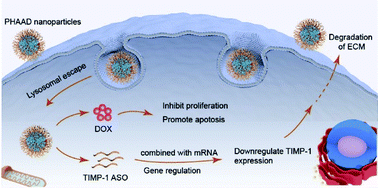Transdermal delivery of poly-hyaluronic acid-based spherical nucleic acids for chemogene therapy†
Abstract
Spherical nucleic acid (SNA), as a good gene delivery system, has a good application prospect for transdermal administration in skin disorder treatment. However, most of the traditional SNA core materials are non-degradable materials, so it is worthy of further research. Herein, we report a spherical nucleic acid based on poly-hyaluronic acid (PHA) for the co-delivery of a typical chemotherapeutic drug, doxorubicin (DOX), and an antisense oligonucleotide (ASO) against the tissue inhibitor of metalloproteinases 1 (TIMP-1) for the treatment of hypertrophic scars (HS) which are caused by abnormal fibroblast proliferation. Our study showed that PHA-based SNAs simultaneously bearing TIMP-1 ASO and DOX (termed PHAAD) could significantly promote skin penetration, improve the cellular uptake, and effectively down-regulate the TIMP-1 expression and enhance the cytotoxicity of DOX. Moreover, PHAAD nanoparticles facilitated the apoptosis of hypertrophic scar cells, and reduced the burden and progression of hypertrophic scars in a xenografted mouse model without adverse side effects. Thus, our PHA-based SNA represents a new transdermal delivery vehicle for efficient combinatorial chemo and gene therapy, which is expected to treat various skin disorders.



 Please wait while we load your content...
Please wait while we load your content...